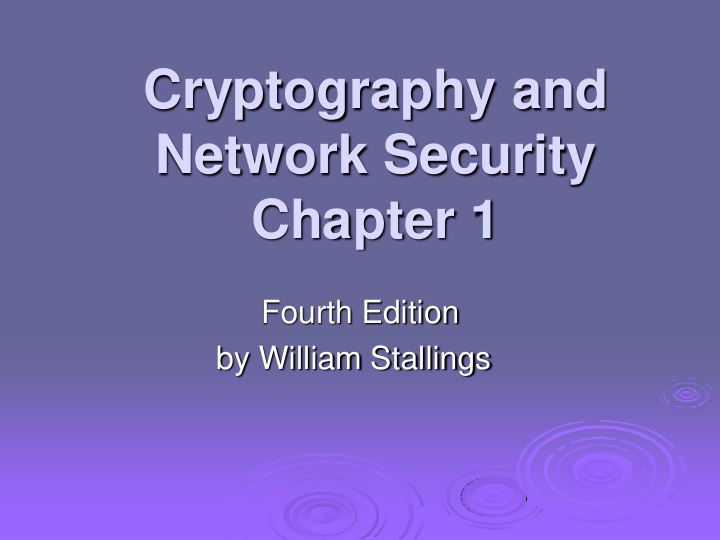



Cryptography and Network Security Chapter 1 Fourth Edition by William Stallings
Chapter 1 – Introduction The art of war teaches us to rely not on the likelihood of the enemy's not coming, but on our own readiness to receive him; not on the chance of his not attacking, but rather on the fact that we have made our position unassailable. — The Art of War, Sun Tzu
Background Information Security requirements have changed in recent times traditionally provided by physical and administrative mechanisms computer use requires automated tools to protect files and other stored information use of networks and communications links requires measures to protect data during transmission
Definitions Computer Security - generic name for the collection of tools designed to protect data and to thwart hackers Network Security - measures to protect data during their transmission Internet Security - measures to protect data during their transmission over a collection of interconnected networks
Aim of Course our focus is on Internet Security which consists of measures to deter, prevent, detect, and correct security violations that involve the transmission & storage of information
Security Trends
OSI Security Architecture ITU-T X.800 “Security Architecture for OSI” defines a systematic way and providing security requirements for us it provides a useful overview of concepts we will study
Aspects of Security consider 3 aspects of information security: security attack : • Any action that compromises the security of information owned by an organization. security mechanism: • A process that is designed to detect, prevent, or recover from a security attack. security service
Aspects of Security security service • A processing that enhances the security of the data processing systems and the information transfers of an organization. The services are intended to counter security attacks, and they make use of one or more security mechanisms to provide the service.
Security Attack any action that compromises the security of information owned by an organization information security is about how to prevent attacks, or failing that, to detect attacks on information-based systems have a wide range of attacks can focus of generic types of attacks passive active
Passive Attacks
Active Attacks
Security Services X.800: “a service provided by a protocol layer of communicating open systems, which ensures adequate security of the systems or of data transfers ”
Security Services (X.800) Authentication - assurance that the communicating entity is the one claimed Access Control - prevention of the unauthorized use of a resource Data Confidentiality – protection of data from unauthorized disclosure Data Integrity - assurance that data received is as sent by an authorized entity Non-Repudiation - protection against denial by one of the parties in a communication
Security Mechanism no single mechanism that will support all services required however one particular element underlies many of the security mechanisms in use: cryptographic techniques hence our focus on this topic
Security Mechanisms (X.800) specific security mechanisms: digital signatures, access controls, data integrity, authentication exchange, traffic padding, routing control, notarization
Model for Network Security
Model for Network Security using this model requires us to: design a suitable algorithm for the security 1. transformation generate the secret information (keys) used 2. with the algorithm develop methods to distribute and share the 3. secret information a protocol to be used by the two principals 4. that makes use of the security algorithm and the secret information to achieve a particular security service
Model for Network Access Security
Model for Network Access Security using this model requires us to: select appropriate gatekeeper functions to 1. identify users implement security controls to ensure only 2. authorised users access information or resources trusted computer systems may be useful to help implement this model
Summary have considered: definitions for: • computer, network, internet security X.800 standard security attacks, services, mechanisms models for network (access) security
Recommend
More recommend